



















|
 |
|
 |

Being a Diadochoi or Successor state, Arche Seleukeia continues to fight in the Macedonian manner, however with an Eastern influence to their armies and tactics. Strecthing from the Aegean Sea in the west to India in the east, many subject peoples of the Seleukid kings contribute different types of units, giving any Seleukid general access to almost any troop type available in the world, from disciplined pike phalanxes to Iranian skirmishers to heavily armored cavalry and elephants.
This unit list has the most common troops that can be fielded by the Seleukids, but should their borders expand other troops can also be recruited that are not listed here.
Pantodapoi (Hellenic Native Spearmen)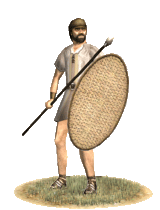 The most basic and numerous of the infantry units used by the non-European Successor States were the Pantodapoi infantry. These men were called from a variety of nationalities and were usually settled in certain areas for garrison duties and the like. There were Jews, Syrians, Cilicians, Persians, Assyrians, Native Egyptians, and many other peoples counted among their number. They are not particularly reliable soldiers, but they are certainly better than their eastern counterparts. They can give a good account of themselves in battle if deployed properly. They wear no armor, and have only a light shield for protection, so most other infantry will slaughter them in droves. They can fend off light cavalry for a time, if need be. The most basic and numerous of the infantry units used by the non-European Successor States were the Pantodapoi infantry. These men were called from a variety of nationalities and were usually settled in certain areas for garrison duties and the like. There were Jews, Syrians, Cilicians, Persians, Assyrians, Native Egyptians, and many other peoples counted among their number. They are not particularly reliable soldiers, but they are certainly better than their eastern counterparts. They can give a good account of themselves in battle if deployed properly. They wear no armor, and have only a light shield for protection, so most other infantry will slaughter them in droves. They can fend off light cavalry for a time, if need be.
Historically, the Pantodapoi were a group of various nationalities that were used as a militia levy and defensive group for towns and villages prone to raiding. While the name is conceptual (meaning, from everywhere), they were a standard fighting force of the day. They were trained rudimentarily, but had enough training to be counted as superior to many militia levies. They had some experience fighting off nomadic raiders, so they can be useful against light troops and some light cavalry.
Akontistai (Hellenic Skirmishers)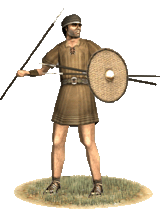 Those unlucky enough to be extremely poor freedmen were pressed into service as psiloi, missile units, and the lowest class of Hellene infantry. The psiloi were divided into three parts: javelineers, slingers, and archers. The javelin-armed psiloi, the akonistai, were ragged peasants armed with javelins and small knives. Their function was simply to throw their missiles and then run as fast as possible to safety behind the hoplitai lines. They were used for skirmishing and to provide a demoralizing hail of missile fire during the grinding battle between the two phalanxes. Never use akonistai in melee except as diversionary fodder or as a flanking force; roles in which they don't excel, but might actually be better than nothing. They have their uses, as their javelins are still sharp and deadly, but they were often used only as light skirmishers or as a last resort in Hellenic armies for obvious reasons. Those unlucky enough to be extremely poor freedmen were pressed into service as psiloi, missile units, and the lowest class of Hellene infantry. The psiloi were divided into three parts: javelineers, slingers, and archers. The javelin-armed psiloi, the akonistai, were ragged peasants armed with javelins and small knives. Their function was simply to throw their missiles and then run as fast as possible to safety behind the hoplitai lines. They were used for skirmishing and to provide a demoralizing hail of missile fire during the grinding battle between the two phalanxes. Never use akonistai in melee except as diversionary fodder or as a flanking force; roles in which they don't excel, but might actually be better than nothing. They have their uses, as their javelins are still sharp and deadly, but they were often used only as light skirmishers or as a last resort in Hellenic armies for obvious reasons.
Historically, akontistai did not play a particularly large role on the battlefield, and weren't normally a particularly decisive force. They were used mainly for their ability to induce an enemy to attack prematurely. They are little more than an annoyance on the open field, but can be deadly if positioned in places where their javelins can be used for maximum effect: on high terrain, on an enemy unit's flank, or atop a city wall.
Gund-i Palta (Eastern Skirmishers)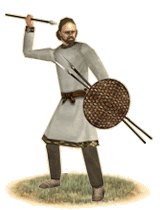 Armed with nothing but a small shield and a handful of javelins these men risk their lives in closing with the enemy with only the lightest of equipment. These men deploy in a cloud before the heavy infantry dashing back and forth to release their deadly missiles. These infantry skirmishers fought in open formations so as to maximize the number of men able to get a throw and minimize the effect of enemy missiles. Lacking armour, training and heavy weapons these light infantry stand no chance if committed to melee. Armed with nothing but a small shield and a handful of javelins these men risk their lives in closing with the enemy with only the lightest of equipment. These men deploy in a cloud before the heavy infantry dashing back and forth to release their deadly missiles. These infantry skirmishers fought in open formations so as to maximize the number of men able to get a throw and minimize the effect of enemy missiles. Lacking armour, training and heavy weapons these light infantry stand no chance if committed to melee.
Historically, most armies of the classical period found use for poorly equipped levies as skirmishers, very often as javelinmen, as these troops required relatively little training and financial investment, relying mostly on widespread natural skills and scant gear, while still providing some useful service.
Sphendonetai (Hellenic Slingers)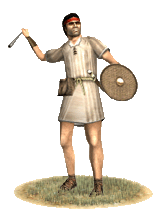 Sphendonetai are the second branch of the psiloi, and are only marginally more useful than their compatriots with javelins. Their sphendonai (slings) can prove deadly weapons, being able to crush bones and armor, and shatter shields from a distance, but they are mainly used to harass and annoy enemy soldiers to force a premature or rash action. Since a sphendone is an easily constructed weapon, and ammo is readily available in Hellas' rocky terrain, Sphendonetai are mostly poor peasants and shepherds that use this weapon to provide a meager amount of protein in their already poor diet or use their weapons to keep predators away from their flocks. Sphendonetai are the second branch of the psiloi, and are only marginally more useful than their compatriots with javelins. Their sphendonai (slings) can prove deadly weapons, being able to crush bones and armor, and shatter shields from a distance, but they are mainly used to harass and annoy enemy soldiers to force a premature or rash action. Since a sphendone is an easily constructed weapon, and ammo is readily available in Hellas' rocky terrain, Sphendonetai are mostly poor peasants and shepherds that use this weapon to provide a meager amount of protein in their already poor diet or use their weapons to keep predators away from their flocks.
Historically, sphendonetai had their uses, they were often used to harass and provoke the enemy forces by causing some casualties and some damage to the enemy's armament, particularly the shields, which were easily dented or cracked by a well slung glande (sling projectile). Alexandros employed his sphendonetai at the battle of Gaugamela to harass the Persian heavy cavalry until they decided to give fight, and then promptly cut them off from the rest of the Persian army, allowing the Hetairoi to cut them to shreds.
Shuban-i Fradakhshana (Eastern Slingers)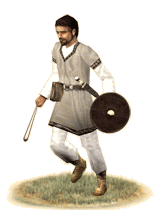 Slings are very easy and cheap to make and, yet, they are a respectable weapon. It is for this reason that they are so prevalent among the poverty-stricken hill tribes of the eastern lands. In battle, slingers are used as light skirmishers, troops with no armour or melee weapons but who rush forward against the enemy to pepper them with stones, only to flee when threatened. The best method of releasing a stone from a sling is by an underhand motion. These missiles can leave the sling in excess of 60 miles per hour. A well trained slinger can hurl a stone as far and as accurately as a good archer. The effect when they strike is nothing short of devastating. Slings are very easy and cheap to make and, yet, they are a respectable weapon. It is for this reason that they are so prevalent among the poverty-stricken hill tribes of the eastern lands. In battle, slingers are used as light skirmishers, troops with no armour or melee weapons but who rush forward against the enemy to pepper them with stones, only to flee when threatened. The best method of releasing a stone from a sling is by an underhand motion. These missiles can leave the sling in excess of 60 miles per hour. A well trained slinger can hurl a stone as far and as accurately as a good archer. The effect when they strike is nothing short of devastating.
Historically, slingers came from the shepherd boys of the highlands who use slings to herd sheep and goats. They stand guard in the upland pastures, and if they see an animal straying, they sling a stone in front of it to ward it back to safety. Ancient hand slings generally consisted of a single long strip of leather or woven wool, with a central "pocket" for the stone. The longer the sling, the greater would be its range. Long-range slings were about 3 feet long.
Toxotai (Hellenic Archers)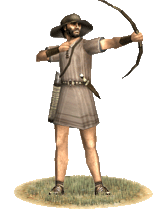 Toxotai are the third branch of the psiloi, the archers of Hellene and Makedonian armies. They are generally from the upper end of the poor and recruited from mountainous regions where the use of the bow is an essential skill to keep one's flock of sheep safe from roving predators. Toxotai are well trained in a manner of speaking, that being that they are using their weapon of choice (often of necessity) from birth. They are decent archers, but are nowhere near as professional as the archers from the east and south. They mostly use the short bow, which means that they are often outgunned by their counterparts from other lands. This reflects their secondary role in a Hellenic army. As most missile units, they will be cut to ribbons in melee, so they should be well protected from enemy ranks. Toxotai are the third branch of the psiloi, the archers of Hellene and Makedonian armies. They are generally from the upper end of the poor and recruited from mountainous regions where the use of the bow is an essential skill to keep one's flock of sheep safe from roving predators. Toxotai are well trained in a manner of speaking, that being that they are using their weapon of choice (often of necessity) from birth. They are decent archers, but are nowhere near as professional as the archers from the east and south. They mostly use the short bow, which means that they are often outgunned by their counterparts from other lands. This reflects their secondary role in a Hellenic army. As most missile units, they will be cut to ribbons in melee, so they should be well protected from enemy ranks.
Historically, the Hellenes did not use archers in any significant fashion. They did not have the composite bows of their neighbors, and their lands were not particularly suited to the cattle and horse farming that supplied the raw material for these bows. Therefore, archers fulfilled the same role as other psiloi: that of long range harassment. The Hellenes and Makedonians had no real tradition of archers and could not recruit any but these shepherds to do this work for them, since they lacked any access to the archers of the east. Most Hellene states relied on Skythian and most importantly Kretan archers to do this for them.
Thanvare Payahdag (Persian Archers)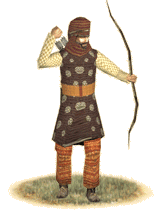 These men are skirmishers only and not inclined to close with enemy troops. These men would have the fully sleeved, long Persian Kapuris tunic. Often brightly coloured these traditional tunics would end just above the knees secured at the waist by a wide woven belt. They would also have a woolen cap, loose trousers and soft felt shoes. They would be armed with the powerful composite bow and a long dagger suitable only for defense. A plain leather quiver would be strung over their back. They would also have a simple woolen cap. These men are skirmishers only and not inclined to close with enemy troops. These men would have the fully sleeved, long Persian Kapuris tunic. Often brightly coloured these traditional tunics would end just above the knees secured at the waist by a wide woven belt. They would also have a woolen cap, loose trousers and soft felt shoes. They would be armed with the powerful composite bow and a long dagger suitable only for defense. A plain leather quiver would be strung over their back. They would also have a simple woolen cap.
Historically, the mainstay of the Parthian infantry were foot archers. These foot archers almost certainly represented the poorer elements of the various infantry levies of Parthia. The tradition of mounted archery in Parthia and the northern steppe peoples makes it almost inevitable that a massed levy would produce significant numbers of foot archers as well. The station usually assigned to these Parthian bowmen is behind the first line of spearmen and forward of them in skirmishing lines. These troops are vital to any armies plan, harassing and confusing enemy troops as they advanced, and shielding the flanks of the battle line from light cavalry and other enemy skirmishing units.
Nizagan-i Eranshahr (Persian Archer-Spearmen)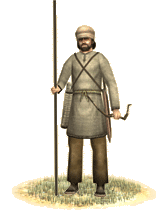 Armed with spear and bow these troops are not well regarded by their Greek masters having formed the bulk of the Old Persian army defeated by Alexander the Great. Seen as skirmishers and auxiliaries with the heavy Greek infantry forming the battle line. These Iranian Spearmen are recruited from the eastern reaches of the Iranian plateau and are very common in the armies of Baktria. They are the backbone of the traditional tribal militia and form a major part of the Baktrian tribal levy. They are armed with the traditional Iranian weapons, an 8' spear and a composite foot bow. A large decorated brown leather quiver of arrows would be slung on the left side with the bow case on the right. A long plain yellow tunic with close fitting sleeves at the wrists. The tunic would be held with an narrow embroidered Parthian linen belt. Trousers are worn under the tunic and are close fitting. Soft felt ankle shoes are secured with leather or fabric straps. Armed with spear and bow these troops are not well regarded by their Greek masters having formed the bulk of the Old Persian army defeated by Alexander the Great. Seen as skirmishers and auxiliaries with the heavy Greek infantry forming the battle line. These Iranian Spearmen are recruited from the eastern reaches of the Iranian plateau and are very common in the armies of Baktria. They are the backbone of the traditional tribal militia and form a major part of the Baktrian tribal levy. They are armed with the traditional Iranian weapons, an 8' spear and a composite foot bow. A large decorated brown leather quiver of arrows would be slung on the left side with the bow case on the right. A long plain yellow tunic with close fitting sleeves at the wrists. The tunic would be held with an narrow embroidered Parthian linen belt. Trousers are worn under the tunic and are close fitting. Soft felt ankle shoes are secured with leather or fabric straps.
Historically, the vast Iranian plateau gave rise to a form of infantry rarely seen in the west. Armed with 8' spear and composite short bow these infantry are well suited to conditions in the east facing nomadic enemies relying on long range archery to which they men are well able to respond. Nomadic cavalry is reluctant to engage close order troops and these men can fill both roles. They are versatile and can be dangerous if used properly. They are however no match for heavily armored infantry. Individually, they are skilled but not outstanding warriors, but their versatility ensures that they will be useful to any commander. These men however, prefer to rely on archery to inflict harm on the enemy. They can hold the line against weaker infantry and cavalry but they cannot be relied upon to put up an extended fight if the situation is not in their favor.
Iudaioi Taxeis (Jewish Spearmen)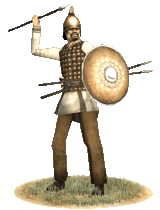 One of the oddities of certain Seleukidos policies produced the armed Ioudaios militia. By some twist of fate these intrepid men from Ioudaia and other places with large Iudaios populations were levied, trained extensively, and set as garrisons in various towns from Lydia to India. For the most part, isolated from their people, they served their Seleukidos lords with distinction. They were generally outfitted in the older Phrygian style helmets and given a spear and shield. They supplemented this with some leather armor made by their families, and went on their way. They form a fair amount of the Seleukidos garrison armies, and are generally reliable spearmen. They are worth far more than their training and expense to the state would credit them for. One of the oddities of certain Seleukidos policies produced the armed Ioudaios militia. By some twist of fate these intrepid men from Ioudaia and other places with large Iudaios populations were levied, trained extensively, and set as garrisons in various towns from Lydia to India. For the most part, isolated from their people, they served their Seleukidos lords with distinction. They were generally outfitted in the older Phrygian style helmets and given a spear and shield. They supplemented this with some leather armor made by their families, and went on their way. They form a fair amount of the Seleukidos garrison armies, and are generally reliable spearmen. They are worth far more than their training and expense to the state would credit them for.
Historically, the Iudaios garrison forces fought hard for the Seleukidos Empire in its losing battle throughout the east, both as Pantodapoi and as these slightly wealthier and much better trained soldiers. They formed the core of the Iudaios revolt later on in the period, but during the first hundred years they were reliable and trustworthy troops. More trustworthy than Persai and natives of Asia Minor, at least.
Katpatuka Zanteush (Cappadoccian Hillmen)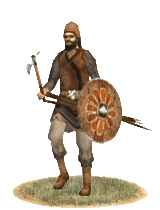 These fierce tribesmen come from the ancient land of Kappadokia, the Hittite, Katpatuka 'land of the beautiful horses'. The tribal warriors raised in the mountains of Kappadokia know the terrain and are well equipped, with javelin and axe, for mountain warfare. They will not do as well away from these heights, as they lack the heavier armour of the Greek infantry. Their axes and javelins will allow them to give a good account of themselves but heavy melee should be avoided. These fierce tribesmen come from the ancient land of Kappadokia, the Hittite, Katpatuka 'land of the beautiful horses'. The tribal warriors raised in the mountains of Kappadokia know the terrain and are well equipped, with javelin and axe, for mountain warfare. They will not do as well away from these heights, as they lack the heavier armour of the Greek infantry. Their axes and javelins will allow them to give a good account of themselves but heavy melee should be avoided.
Historically, while some of the tribes living in the mountains were hostile towards the Greeks, others cultivated very close relationships with them. It is from these mountain warriors the Tibareni and Chaldaei tribesmen, the Mossynoecians, Makrones and other tribes residing in the eastern part of Northern Anatolia, that the skirmishers of Pontos are recruited. the terrain of Pontos is well suited to the style of warfare these men are practiced at. The Pontic Alps stand as a wall between the interior plateau and the rich, narrow plain bordering the sea. These tribes ward the mountain approaches and the kings of Pontos know well the value of such friendship. Xenophon too found such frienship of great value in his passage of these regions. Many of these mountains are thoroughly impassable and altogether precipitous, and there are extensive areas devoid of human habitation, only plunging ravines from which it is impossible to climb out, forested heights and impassable chasms.
Peltastai (Hellenic Heavy Skirmishers)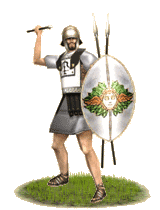 The Peltastai is a type of elite skirmisher that sacrifices heavy arms and armor for mobility and range. They are armored in linen and carry a medium sized ovular shield. Originally, they carried a crescent shaped 'pelta' shield, originated in Thrake and gave the peltastai their name, but this was phased out in the fourth century. Their armaments consist of several javelins and a sword. This panoply makes them light and mobile, but still able to engage in melee after their javelins have been thrown. They are a versatile unit but one must remember that their primary arms are javelins, and they are not equipped to stand toe to toe with heavier infantry. Their role is one of speed, harassment, and critical flanking maneuvers. The Peltastai is a type of elite skirmisher that sacrifices heavy arms and armor for mobility and range. They are armored in linen and carry a medium sized ovular shield. Originally, they carried a crescent shaped 'pelta' shield, originated in Thrake and gave the peltastai their name, but this was phased out in the fourth century. Their armaments consist of several javelins and a sword. This panoply makes them light and mobile, but still able to engage in melee after their javelins have been thrown. They are a versatile unit but one must remember that their primary arms are javelins, and they are not equipped to stand toe to toe with heavier infantry. Their role is one of speed, harassment, and critical flanking maneuvers.
Historically, the peltastai were often hoplitai or pezhetairoi equipped to fight in the manner of a skirmisher. This meant that they were adept melee combatants as well as being deadly with their javelins. Peltastai were used to great effect on ancient battlefields but by 270 BC the thureophoros was becoming the dominant melee skirmisher and the peltastai were carrying more javelins and were used in a manner that was consistent with this. This was simply a matter of specialization, and it did not mean that peltastai would be any less effective if deployed correctly. Their light armament makes them extremely fast, but tends to be to their detriment in melee combat. They were mostly used in the role of supporting missile troops who charged in at the last moment, after they had spent all their javelins. The great Athenian general Iphikrates is credited with the invention of the peltast as a distinct unit, and it is he that first employed them in this manner to great effect against the heavier armored and better trained hoplitai of Sparte.
Misthophoroi Uazali (Mercenary Karian Warband)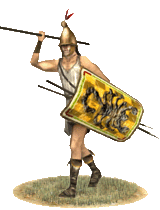 The Uazali are warbands of soldiers from the peoples of the southern coast of Mikra Asia: the Karians, Lykians, Pamphylians, and Pisidians. These warlike peoples have long traditions of military service abroad, and of nearly constant local warfare between the small cities and towns separated by the towering heights of the western Taurus. These Uazali are skilled mountain fighters. Their name comes from the Lykian tongue, and means "Warriors," and is similar also to the words used by the other peoples along the southern coast of Mikra Asia, all of whose languages derived primarily from the Hittite tongue. The Uazali carry a solid rectangular shield slung over the shoulder to ease the burden on the arms, emblazoned with signs of their peoples, and wear a solid Phrygian helm, a common form of protection among those in Asia who could afford such things. For weapons, they carry several javelins and a lengthened xiphos sword, which became a popular weapon in Mikra Asia, both as a result of the Iphikratid reforms, and out of experience fighting the Galatai, with their longswords. Their shields and helmets provide them a great deal of protection compared to most other skirmishing units, and their ferocity in melee surpasses most of their peers. The Uazali are warbands of soldiers from the peoples of the southern coast of Mikra Asia: the Karians, Lykians, Pamphylians, and Pisidians. These warlike peoples have long traditions of military service abroad, and of nearly constant local warfare between the small cities and towns separated by the towering heights of the western Taurus. These Uazali are skilled mountain fighters. Their name comes from the Lykian tongue, and means "Warriors," and is similar also to the words used by the other peoples along the southern coast of Mikra Asia, all of whose languages derived primarily from the Hittite tongue. The Uazali carry a solid rectangular shield slung over the shoulder to ease the burden on the arms, emblazoned with signs of their peoples, and wear a solid Phrygian helm, a common form of protection among those in Asia who could afford such things. For weapons, they carry several javelins and a lengthened xiphos sword, which became a popular weapon in Mikra Asia, both as a result of the Iphikratid reforms, and out of experience fighting the Galatai, with their longswords. Their shields and helmets provide them a great deal of protection compared to most other skirmishing units, and their ferocity in melee surpasses most of their peers.
Historically, many young men from Karia, Lykia, Pamphylia and Pisidia went overseas to serve as mercenaries, or were recruited in their native lands as militias and katoikoi for the successors. Many of the most Hellenized inhabitants joined the ranks of thureophoroi and other medium infantry units in other lands. Many others, however, stayed closer to their native infantry traditions, and served abroad as warrior bands, or as locally-recruited troops in their own lands. They were used to great effect in irregular mountain combat, but also distinguished themselves in assaults, and if they end up in the battle line in major pitched battle, a good commander will maximize their skirmishing and melee abilities by using them in a flanking, ambushing, or screening role if at all possible.
Toxotai Syriakoi (Syrian Archers)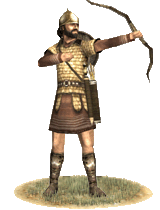 Toxotai Syriakoi are armed with composite bows, which make them a class above most archers. They have long ranged bows and carry a good amount of arrows, and know how to use these bows through centuries of tradition in their homelands and a constant need to supplement their poor diets with meat. They are good soldiers, but suffer from a morale problem since they are a subjugated people. They can be expected to use their arrows to devastating effect, but when engaged in melee, they will be cut down in droves. Toxotai Syriakoi are armed with composite bows, which make them a class above most archers. They have long ranged bows and carry a good amount of arrows, and know how to use these bows through centuries of tradition in their homelands and a constant need to supplement their poor diets with meat. They are good soldiers, but suffer from a morale problem since they are a subjugated people. They can be expected to use their arrows to devastating effect, but when engaged in melee, they will be cut down in droves.
Historically, Syria has been famous for its archers for thousands of years. These men took part in almost every major Near Eastern war since the early Assyrian kingdom used them as auxiliary troops. They have been a decisive arm on the battlefield time and time again, so long as they are supported by good infantry. A sensible commander will take their strengths and weaknesses into account before using them.
Pantodapoi Phalangitai (Hellenic Native Phalanx)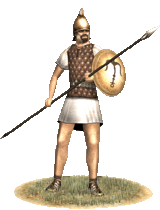 Pantodapoi Phalangitai are the standard levy of the Seleukidos Kingdom and others influenced by the Diadochoi, including Pontos. They are tough and reliable infantry, but are prone to rebellion and discontent, and are hence more expensive than their Makedonian contemporaries. They are mostly levies of Iudaioi, Syrioi, and Persai descent that are co-opted into the army. They fight as pikemen, with a soft leather cuirass, pikes, round Illyrian style shields and Phrygian caps. This makes them a viable pike unit, though they are less disciplined and more prone to flee than more reliable Hellenes and Makedonians that make up the Pezhetairoi. They can be counted upon to present a solid wall of spear points to the enemy, but their lack of discipline and intensive training makes them even more prone to a flanking attack. Pantodapoi Phalangitai are the standard levy of the Seleukidos Kingdom and others influenced by the Diadochoi, including Pontos. They are tough and reliable infantry, but are prone to rebellion and discontent, and are hence more expensive than their Makedonian contemporaries. They are mostly levies of Iudaioi, Syrioi, and Persai descent that are co-opted into the army. They fight as pikemen, with a soft leather cuirass, pikes, round Illyrian style shields and Phrygian caps. This makes them a viable pike unit, though they are less disciplined and more prone to flee than more reliable Hellenes and Makedonians that make up the Pezhetairoi. They can be counted upon to present a solid wall of spear points to the enemy, but their lack of discipline and intensive training makes them even more prone to a flanking attack.
Historically, the Seleukidoi and others used pike levies from their various subject peoples to make up parts of the battle line that were facing the enemy's least valuable troops. They gave decent accounts of themselves at many battles, but were the first line to break in the disasters at Raphia against the Ptolemies and in Makedonia against the Romaioi. They made up more and more of the Seleukidos battle line as time went on, due to the dwindling number of Hellene recruits that the army could draw upon for the pike units (most went to the more elite units), and more and more Asian peoples were put into the Pezhetairoi class and given land grants, to make up the loss, yet these more unreliable formations were still used in many places.
Klerouchoi Phalangitai (Hellenic Medium Phalanx)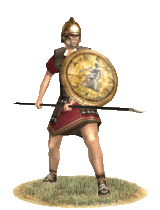 The Klerouchoi Phalangitai form the backbone of the Successor armies of Aigyptos and Asia, along with the less numerous Pezhetairoi. These men are given a plot of land or kleros, maybe some slaves and a tax reduction and in return they serve in the phalanx when called upon to war by their Basileus. They are citizens just as the Pezhetairoi, but they are citizens with-strings-attached, as they are required to fight when called upon or otherwise their livelihood might be taken away from them. The Klerouchoi Phalangitai form the backbone of the Successor armies of Aigyptos and Asia, along with the less numerous Pezhetairoi. These men are given a plot of land or kleros, maybe some slaves and a tax reduction and in return they serve in the phalanx when called upon to war by their Basileus. They are citizens just as the Pezhetairoi, but they are citizens with-strings-attached, as they are required to fight when called upon or otherwise their livelihood might be taken away from them.
Even though the phalanx is a Hellenic soldier formation, some Thraikes, Keltoi, Ioudaioi and other subjects were also given Klerouchos status to increase the number of Phalangitai available, but the main bulk of the Klerouchoi Phalangitai are still Hellenes. Each soldier is armed with the sarissa and wears a linen or leather cuirass, a Thracian helm, and a Makedonian pelte provided by the Basileus. In battle they are best deployed in a defensive posture, or in a slow but steady advance towards the enemy, grinding down their opponents' numbers through attrition, or to pin enemy formations so they can be flanked by other units.
The wars which followed the breakup of Megas Alexandros' empire drained the Makedonian armies of many of their Makedones. For the western Diadochoi, levies from populations could take place directly, but the eastern Diadochoi depended on their dwindling standing armies or on new mercenary recruits. They needed a renewable source of Hellenic recruits if they were to keep power and retain their military strength. As the pike-phalanx was the backbone of their armies, they needed Hellenes to fill its ranks. While mercenaries could temporarily fulfill such a need, their loyalty was never assured, while their demands for pay always were.
The answer was the establishment of Hellenic military-settlements throughout the Successor states, where a soldier was given a plot of land and reduced taxes. Sometimes they were given some slaves too, to work their alloted land, freeing up more time for the Klerouchos soldier to be on campaign. Arming the native population (Aigyptioi in the Ptolemaic kingdom, Syriakoi and Babylonioi in the Seleukid Empire), was less appealing, as that would have laid the Makedonian dynasties open for native revolts in their respective heartlands. In Aigyptos most Klerouchoi were settled in the Fayum depression, but many others were settled further to the south, though in smaller numbers.
Klerouchoi were also settled by the Ptolemaioi in settlements in Asia, Kypros, and Koile Syria, but nearly all Hellenic, Klerouchoi Phalangitai were settled in Aigyptos, and primarily in the Arsinoite and Herakleopolite nomes, in or near the Fayum. In the Arche Seleukeia these settlements, called Katoikiai, were established in western Asia around Sardis, throughout Syria and Mesopotamia, and as far away as Baktria and Paropamisadai. The Klerouchoi population in Aigyptos eventually deteriorated, and lost much of its martial character after the arrival of the Romans, while the Katoikiai in Seleukid regions, especially those in western Asia, passed into the hands of the Pergamenes first, then Pontos, and finally the Romaioi.
Pezhetairoi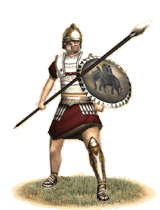 The Pezhetairoi are heart of the military machine of all the Diodachoi kindgoms. They are well disciplined and highly motivated pikemen that are armed and armored to the teeth. They are armored in a linen cuirass, a Thraikian cap, a bronze greave on the left leg, stout boots, good bracers, and reinforced shoulder pads made from hardened linen (due to their experience with the deadly curved swords of Thrace). They have Illyrian style round shields attached to their bodies by leather straps that help support the weight of the shield and keep their hand free to grasp the long and unwieldy sarissa. They are defensive infantry par excellence and are the anvil of the two part Makedonian system of warfare, the heavy cavalry being the hammer. They should be used to anchor enemy soldiers while the Theurophoroi harass the flanks and the heavy cavalry smashes into the flanks and rear. The Pezhetairoi are heart of the military machine of all the Diodachoi kindgoms. They are well disciplined and highly motivated pikemen that are armed and armored to the teeth. They are armored in a linen cuirass, a Thraikian cap, a bronze greave on the left leg, stout boots, good bracers, and reinforced shoulder pads made from hardened linen (due to their experience with the deadly curved swords of Thrace). They have Illyrian style round shields attached to their bodies by leather straps that help support the weight of the shield and keep their hand free to grasp the long and unwieldy sarissa. They are defensive infantry par excellence and are the anvil of the two part Makedonian system of warfare, the heavy cavalry being the hammer. They should be used to anchor enemy soldiers while the Theurophoroi harass the flanks and the heavy cavalry smashes into the flanks and rear.
Historically, the Pezhetairoi are the classic Alexandrian phalanx. They were used to great effect against the Persai, Medoi, Baktrioi, Indoi, Phoinikoi, and many, many others. They are an effective force and have not changed much over the centuries. The Romaioi were able to defeat them as easily as they did for two main reasons. One, the Romaioi army was at a high state of readiness and tactical prowess after defeating the Karchedoi. Two, the heavy cavalry arm of the Diodochoi armies had degenerated to the point where they were no longer able to field significant numbers to fulfill their part of the hammer and anvil tactic of Alexandros. There were also many lesser reasons, numbering among them the misuse of the Thureophoroi, the under use of Peltastai, and the lax state of warfare that the Diodachoi states were used to. In any case, the phalanx was not as anachronistic or inflexible as widely believed; it was simply misused and under-supported. In the thirteenth century and onwards, pikemen in similar formations were able to work wonders with more capable generals and a better cavalry arm. Do not under appreciate pikemen, for they are still a war winning force.
Thureophoroi (Hellenic Spearmen)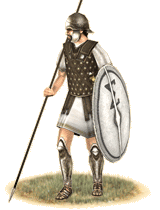 Thureophoroi were a new class of Hellenic infantry that was designed to both augment the phalanx and provide a type of soldier in between the phalangite and the peltastai that was able to both skirmish and fight in melee effectively. These men provide an extremely mobile force that can hit hard with their heavy javelins then rush in to flank pike units. They are well armed and armored for the task, having stout bronze helms, linen armor, an almond shaped thureos shield, heavy javelins, and a stout spear. They are highly versatile infantry, akin in spirit to the legionaries of Rome. They are a highly effective force of heavy infantry that is in the forefront of Hellenic military know-how. Thureophoroi were a new class of Hellenic infantry that was designed to both augment the phalanx and provide a type of soldier in between the phalangite and the peltastai that was able to both skirmish and fight in melee effectively. These men provide an extremely mobile force that can hit hard with their heavy javelins then rush in to flank pike units. They are well armed and armored for the task, having stout bronze helms, linen armor, an almond shaped thureos shield, heavy javelins, and a stout spear. They are highly versatile infantry, akin in spirit to the legionaries of Rome. They are a highly effective force of heavy infantry that is in the forefront of Hellenic military know-how.
Historically, Thureophoroi were used as harassing and flanking troops by the successor states. Though they were often described by Latin writers as copies of the legion, it is debatable whether they were developed with knowledge of warfare in Italy or not. Most Thureophoroi were Pezhetairoi, middle class property owners with voting rights, and as such, they were well able to devote time to training and practice and were highly disciplined and courageous troops. Despite their obvious advantages, or perhaps because of them, there was a lot of confusion as to how to utilize these new soldiers. As were deadly in the extreme to the less mobile phalanx units they forced a, much resisted, revaluation of Hellenic warfare. Perhaps for this reason the Diodachoi tended to used them conservatively, except for the Seleukidai, who took to these new soldiers quite well. The city-states of Hellas used them even more frequently against the armies of Makedonia, and were often able to hold the more powerful kingdom at bay. Still, their uses were limited in scope and not as widespread as their versatile and deadly role would have indicated. This is the fault of period commanders, however, and a more astute or innovative commander might have realized their potential in conjunction with the more static phalanx.
Thorakitai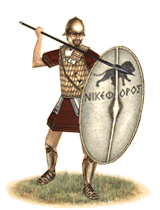 The Thorakitai represent the second evolution of the concept of the Theurophoroi, and show definite influence by the Romaioi in their implementation. They are armored in mail and carry heavy javelins instead of the lighter javelins carried by the Thureophoroi. They are more expensive and less mobile than their more lightly armored companions, but make excellent shock troops for any Hellenic army. They are best utilized on the flanks of the phalanx to either flank the enemy while the phalanx pins them, or prevent enemy flankers from attacking the phalanx's vulnerable flanks. They are best used in combination with the lighter Thureophoroi, who can support them with extra javelins and more importantly, speed, to make sure they are not surrounded. The Thorakitai represent the second evolution of the concept of the Theurophoroi, and show definite influence by the Romaioi in their implementation. They are armored in mail and carry heavy javelins instead of the lighter javelins carried by the Thureophoroi. They are more expensive and less mobile than their more lightly armored companions, but make excellent shock troops for any Hellenic army. They are best utilized on the flanks of the phalanx to either flank the enemy while the phalanx pins them, or prevent enemy flankers from attacking the phalanx's vulnerable flanks. They are best used in combination with the lighter Thureophoroi, who can support them with extra javelins and more importantly, speed, to make sure they are not surrounded.
Historically, the Thorakitai were used much like the Thureophoroi, but more rarely and later on. They were expensive soldiers, and one had to be fairly wealthy to equip one's self as a Thorakites. They were only used in any real numbers by the Seleukidai and the city-states of Hellas. They were never used to their full potential until the Romaioi raised legions in Hellas, and the type of fighting practiced by the Romaioi Legions and Thorakitai became the norm rather than the exception.
Tabargane Eranshahr (Eastern Axemen)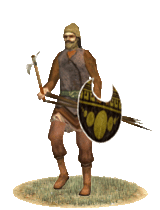 The Tabargân are steadfast warriors, aggressive and impetuous in temperament, valued by Iranians, and Hellenes alike for their ferociousness and courage. These hillmen are recruited as irregulars from the mountains of Iran, not least from the Zagros and Elburz ranges, areas that breed toughness and have done so for centuries. Though certainly not as disciplined as Hellenic heavy infantry, nor even comparably attired, They are armed with the Sagaris, or the "Persian pick-axe" (Ironically being Scythian in origin) which they wielded with skill, and a bundle of javelins, they were prepared for guerilla warfare tactics such as ambushes, surprise attacks and particularly fond of broken terrain where disciplined troops accustomed to fighting in formation would fare badly. This is facilitated by their light attire, as they bear no armour and the only true means of protection is a light shield, nimble movement and dauntless impetus, casting themselves into the fray. Distinguished by traditional Iranian highlander garb such as the Kyrbasia cap, baggy trousers, a woolen tunic, boots and a thick sheep-skin jerkin, these tough hillmen could almost be mistaken for shepherds or nomadic herders. However these hardy hillmen are nothing to scoff at, as the pick-axe could puncture helmets, and penetrate bronze and iron armour. The Tabargân were no less skilled with their javelins, in which the usage of javelin-thongs increased the stopping power and accuracy of the javelin, giving it a spin during flight. Using them properly, they will give a good account of themselves. Using them poorly on the other hand may prove suicidal and their dauntless bravery may quickly turn into fragile bravado. The Tabargân are steadfast warriors, aggressive and impetuous in temperament, valued by Iranians, and Hellenes alike for their ferociousness and courage. These hillmen are recruited as irregulars from the mountains of Iran, not least from the Zagros and Elburz ranges, areas that breed toughness and have done so for centuries. Though certainly not as disciplined as Hellenic heavy infantry, nor even comparably attired, They are armed with the Sagaris, or the "Persian pick-axe" (Ironically being Scythian in origin) which they wielded with skill, and a bundle of javelins, they were prepared for guerilla warfare tactics such as ambushes, surprise attacks and particularly fond of broken terrain where disciplined troops accustomed to fighting in formation would fare badly. This is facilitated by their light attire, as they bear no armour and the only true means of protection is a light shield, nimble movement and dauntless impetus, casting themselves into the fray. Distinguished by traditional Iranian highlander garb such as the Kyrbasia cap, baggy trousers, a woolen tunic, boots and a thick sheep-skin jerkin, these tough hillmen could almost be mistaken for shepherds or nomadic herders. However these hardy hillmen are nothing to scoff at, as the pick-axe could puncture helmets, and penetrate bronze and iron armour. The Tabargân were no less skilled with their javelins, in which the usage of javelin-thongs increased the stopping power and accuracy of the javelin, giving it a spin during flight. Using them properly, they will give a good account of themselves. Using them poorly on the other hand may prove suicidal and their dauntless bravery may quickly turn into fragile bravado.
Historically, the northern Iranian highlands are known for their hardy mountaineers who held all transgressors at bay. These men of the mountains were lightly ruled by all Persian Grandees who valued their warrior skills over what meagre income their mountain homes might bring. These men would be recruited from the warlike Gîlânî and Dailamî tribesmen of Verkhânâ (Hyrcania), and other similar peoples of northern Media. The earliest origins of these people are unknown, although the Dailamites could be the descendants of such ancient peoples as the Delumïoi (Delumioi) and Karduchoi (Kadousioi or the Cadusians) mentioned by Ptolemy in 2 AD. Classical historians mention Dailamites, 'Dolomites' or other very similar names repeatedly and their name is particularly mentioned in context with the later Byzantine Varangian Guard. Due to the mingling of migrant tribes with the indigenous residents of the region, several new clans were formed, of which, the two tribes of 'Gill' and 'Daylam' formed a majority. In the 6th century BC, the inhabitants of Gîlân allied with Kûroush (Cyrus) the Great and overthrew the Medes helping to establish the Achaemenid Persian Empire. The Dailamites would later during the Sassanid dynasty form a core of heavy infantry with fine equipment including brightly painted shields and two-pronged javelins, meant to be pitted against the finest Roman infantry. However, that is a long way from the continuously more declining irregular force, the Takâbarâ as they were called by the Achaemenids, and in Parthian history, the Tabargân are merely the residue of the Iranian highlander spirit, not exclusive to the Elburz range but to all areas of Iran where the environment breeded toughness.
Asabaran-i Hauravatish (Arachosian Skirmisher Cavalry)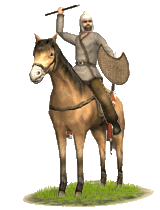 These horsemen from Arachosia are best used in a harassing role and can be very useful trying to tempt enemy heavy cavalry to mount a charge in a vain attempt to catch them. They would be wearing the Persian Kyrbasia, a soft grey-white cloth cap extending down around the neck, made of fabric and able to be pulled down over his face when marching through desert regions. They would wear dirty grey sheepskin coats with bright embroidered trim. They would wear baggy embroidered dark red trousers and knee high, brown leather boots. A coarse rain resistant felt cape, or cherkesska was also donned in winter. Also worn was a leather belt with elaborate buckles, which are decorative in themselves and used to support weapons. They would have a spear and 3-4 javelins in two embossed leather cases mounted just behind the saddle on either side. Up to as many as 6-8 such javelins cold be carried in all the cases. Their protection would be enhanced by a small crescent shaped 'Taka' shield. The brightly coloured saddle cushion would be u-shaped and made of sheepskin or cloth and stuffed with straw. These horsemen from Arachosia are best used in a harassing role and can be very useful trying to tempt enemy heavy cavalry to mount a charge in a vain attempt to catch them. They would be wearing the Persian Kyrbasia, a soft grey-white cloth cap extending down around the neck, made of fabric and able to be pulled down over his face when marching through desert regions. They would wear dirty grey sheepskin coats with bright embroidered trim. They would wear baggy embroidered dark red trousers and knee high, brown leather boots. A coarse rain resistant felt cape, or cherkesska was also donned in winter. Also worn was a leather belt with elaborate buckles, which are decorative in themselves and used to support weapons. They would have a spear and 3-4 javelins in two embossed leather cases mounted just behind the saddle on either side. Up to as many as 6-8 such javelins cold be carried in all the cases. Their protection would be enhanced by a small crescent shaped 'Taka' shield. The brightly coloured saddle cushion would be u-shaped and made of sheepskin or cloth and stuffed with straw.
Historically; Armed chiefly with javelins these horsemen hail from Arachosia, Bactria, Sogdiana, and similarly equipped light cavalry was supplied by the levy from Persis and Media. The flexible nature of this light cavalry makes them well suited to the fluid, aggressive style of warfare so common on the eastern frontiers. Mounted on a swift horse, armed with nothing but a small crescent shaped 'Taka' shield, short spear, and a handful of javelins these swift moving horsemen can be deadly. Their small, nimble mountain ponies can negotiate most terrain easily, and they're capable enough to survive contact with the enemy, but their strength remains in maintaining their loose style of fighting. Equipped with javelins these cavalry would advance on their target at less than a gallop. As each rank came into range, these warriors would turn away, hurling their javelins at the target, and retire to safety before the enemy could retaliate. The result is often a swirling mass of charging and counter charging horsemen as the light horse would reform to charge again.
Asabaran-i Madaen (Median Medium Cavalry) In the Seleucid and Bactrian armies, these medium Median cavalrymen are very prevalent. Descended from the lesser Persian nobility they now render good service to their new masters. They are excellent medium cavalry, capable of skirmishing, charging, and fighting fairly well in melee. These cavalry are raised from the old Persian estates that had not seized by the Macedonian invaders. They are equipped with a cavalry spear and the single bladed Tabar axe with a vicious back-spike, well capable of penetrating heavy armor. The battle-axe was often used, especially by North Iranians. The spear was usually used over arm as a thrusting weapon. The shield used by these horsemen was the crescent shaped Scythian Taka shield. A conical Persian helmet of iron is worn with brightly colored helmet plume. Their armor is a scale cuirass with scaled shoulder guards and stiffened leather pteruges hanging from the waist. Loose richly embroidered trousers and a long sleeved tunic extending down to just above the knees, is secured by a leather belt. The horse has a stuffed Persian saddle and thick, bright colored saddle cloth. The tails were tied up to prevent it being grabbed by the enemy. The forelock was left long and tired with ribbon to form a plume above the head. In the Seleucid and Bactrian armies, these medium Median cavalrymen are very prevalent. Descended from the lesser Persian nobility they now render good service to their new masters. They are excellent medium cavalry, capable of skirmishing, charging, and fighting fairly well in melee. These cavalry are raised from the old Persian estates that had not seized by the Macedonian invaders. They are equipped with a cavalry spear and the single bladed Tabar axe with a vicious back-spike, well capable of penetrating heavy armor. The battle-axe was often used, especially by North Iranians. The spear was usually used over arm as a thrusting weapon. The shield used by these horsemen was the crescent shaped Scythian Taka shield. A conical Persian helmet of iron is worn with brightly colored helmet plume. Their armor is a scale cuirass with scaled shoulder guards and stiffened leather pteruges hanging from the waist. Loose richly embroidered trousers and a long sleeved tunic extending down to just above the knees, is secured by a leather belt. The horse has a stuffed Persian saddle and thick, bright colored saddle cloth. The tails were tied up to prevent it being grabbed by the enemy. The forelock was left long and tired with ribbon to form a plume above the head.
Historically; The Macedonians came to Persia as invaders, sharing neither a common culture nor a common enemy. These lesser nobles are quick to make cause with any rebel, and the Greek upper class know this well. The Seleucids, and Baktrians intent on Hellenizing Iran, cannot rely on these men who are descended from a proud tradition, the Huvaka, Kinsmen cavalry who had faced Alexander the Great during late imperial times. It is for this reason that the Greeks often preferred to rely on mercenaries and Greek settlers, but these men are still able to be used in some roles and are conscripted in times of need. Some of these minor noble houses have intermarried with their Macedonian overlords and are thus somewhat more loyal than their neighbours might be. Still, they are often present in native revolts, due to the fact that they can often lead these revolts and have fewer opportunities due to their Iranian blood.
Khuveshavagan (Persian Heavy Cavalry)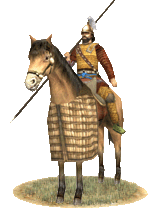 The Khuveshavagan used to be the most expensively attired cavalry in the world, and were indeed the sign of the equestrian power of the Achaemenid world order. With the coming of Macedonian cavalry tactics, the Khuveshavagan had undergone several changes. The final product was an extra-heavy cavalry unit, magnificently equipped with the finest technology mustered by the Achaemenids. Financed by the royal treasuries, they were made into a contingent of specific honour, The Kinsmen. Armed with a xyston, and a machaira along with the deployment in column formation, this unit was purely equipped for melee combat, like the later cataphracts. The mount being barded with peytrel, chamfrôn and the parameridia or armoured saddle, made this unit a particularly headstrong opponent worthy of respect. The Khuveshavagan used to be the most expensively attired cavalry in the world, and were indeed the sign of the equestrian power of the Achaemenid world order. With the coming of Macedonian cavalry tactics, the Khuveshavagan had undergone several changes. The final product was an extra-heavy cavalry unit, magnificently equipped with the finest technology mustered by the Achaemenids. Financed by the royal treasuries, they were made into a contingent of specific honour, The Kinsmen. Armed with a xyston, and a machaira along with the deployment in column formation, this unit was purely equipped for melee combat, like the later cataphracts. The mount being barded with peytrel, chamfrôn and the parameridia or armoured saddle, made this unit a particularly headstrong opponent worthy of respect.
With the royal treasuries withdrawn and the adoption of additional Macedonian conventions, the Khuveshavagan are no longer "Kinsmen" per se. Only in appearance have most of the fearsome features been retained. Still heavily armoured they make a respectable contender, and a reliable heavy cavalry they are only truly inferior to the proper cataphracts in the matter of equipment and tactics. Armed with a xyston and a machaira this full-contact unit can mount a terrible charge, wreaking havoc upon the enemy and additionally being clad entirely in bronze and the horse being armoured with an exotic combination of chamfrôn, peytrel and the parameridia, it must certainly have been a most impressive unit, both an ornament to whomever affording these warriors and a fearsome enemy. However, the unit being in decline (Due to being financed by nobles rather than the royal treasury) and increasingly archaic vis-a-vis to the torrent of improved cavalry equipment being developed in the steppes, will make this unit only useful as an option of heavy cavalry before cataphracts can be fielded.
Historically, the late Achaemenian heavy cavalry was an amalgam between Iranian horsemanship and an increasingly higher need for resilient and headstrong cavalry for shock tactics. Chariots, in particular scythed were most fearsome with a ample support, specifically heavy cavalry. The cavalry reforms of the latter half of the 5th century reached its apex during the patronage of the Persian Commander-in-Chief Pharnabazus, distinguished through Xenophon as a capable general, where the Persian "Cuirassiers" were not lined up for close combat but rather organized in columns for a sustained momentum in a charge. In accordance with the relief of Bozkir and some clear depictions of a parameridia (The armoured saddle), and earlier mention of horse armour in the form of peytrel and chamfrôn (As a nose-plate), this cavalry must have been quite heavily armoured. This cavalry, other than being depicted as the bodyguard of Cyrus The Younger during the civil war of Achaemenid Persia, was about to get a second overhaul, a step closer to the heavily armoured cataphracts of later Iranian dynasties. By then, the Persian army was beginning to become more Hellenized, which included certain Greek sabres.
During 372 BCE, Datames replaced Pharnabazus as the Commander-in-Chief of the Persian armies, and other than being accredited for the concept of a Persian hoplite'esque troop type, the Cardaces, Xenophon in his written work "Horsemanship", does not only recommend the parameridia, but also lauds an invention called "The arm", a very possible and likely addition of laminated armour, or as they are called in Greek, the "cheires". It is often suggested that Seleucid heavy cavalry came to adopt the banded/laminated armour for the arms from the Achaemenians. However, before the demise of the Achaemenians, a third reform was made during the reign of Darius III Codomannus, after the battle of Issus. Modelled after previous Achaemenid as well as Bactrian style armour, and combined Sakae and Macedonian cavalry tactics, the Hûvakâ of Darius was an interesting, but nonetheless fearsome amalgam. By the end of the Achaemenid dynasty, the Persians had two types of shock cavalry, the most popular undoubtly the scythed chariot often pulled by armoured horses and lead by heavily armoured crew. The second being an exotic variety of extra-heavy cavalry, household but also recruited from the Bactrians, Massagetae, Sakae, Cappadocians, Armenians and even westernly Scythians. The interesting aspect is that instead of completely relying on local traditions, the Achaemenians pursued their own reforms of the heavy cavalry. While for most of its lifespan being more of a extra-heavily armoured skirmisher cavalry with the ability to mount a charge in column formation, it evolved into a unit meant for full contact. It was aptly named the "Huvaka", meaning "The Kinsmen", something translated by Pahlavî as "xwesawand" or "Khuveshavagan".
Naturally this would also require not only great physique and vigour of the mountee, but the requirements of the mount would be more strict as well. A horse, able to support a heavily armoured rider and some barding needed to be heavy-boned, tall, and muscular. Historically, by the end of the Achaemenian era, Persian emperors were given tribute, often in the form of horses. Cyrus The Great himself valued horses besides good weapons and chariots, as quoted from Herodotus. The main breeds for heavier cavalry were the Cappadocians, as earlier trained to serve as mounts for the famed Lydian lancers and subsequently the Perso-Hellenic kingdom of Pontus, as well as the Armenian horses known for their resilience, and finally the Mede and Parthian (Nisaean) breeds, in which especially the latter was not only known as perhaps the bulkiest of horses but also remarkably speedy, said to outrun the Iberian horses used by the Romans. Therefore it would seem that Achaemenian cavalry tradition formed the basis of subsequent Armenian and Pontic heavy cavalry, as well as providing the Seleucids with a vast range of not only heavy cavalry auxiliaries but also a variety of mounts. The Armenians and the Persian nobles of Pontus, being greatly influenced by Persian trends would most certainly have continued the tradition.
As a means of support for chariots, it could facilitate the sheer violence of the chariot charge as written by Xenophon: "The soldiers had got into the habit of collecting their supplies carelessly and without taking precautions. And there was one occasion when Pharnabazus, with 2 scythed chariots and about 400 cavalry, came on them when they were scattered all over the plain. When the Greeks saw him bearing down on them, they ran to join up with each other, about 700 altogether; but Pharnabazus did not waste time. Putting the chariots in front, and following behind them himself with the cavalry, he ordered a charge. The chariots dashing into the Greek ranks, broke up their close formation, and the cavalry soon cut down about a hundred men. The rest fled and took refuge with Agesilaus, who happened to be close at hand with the hoplites." (Xenophon Hellenica IV,1,17-19)
Asiatikoi Hippakontistai (Eastern Light Cavalry)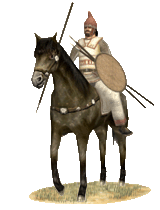 These Asiatikoi horsemen represent a light, but versatile unit well able to skirmish and to perform screening duties. They have their uses in pursuit and thanks to their skills in using spears in melee, they are also the bane of light infantry. As light auxiliaries, they are also armoured with a linen corselet giving them light protection and more staying power than most other light cavalry. They are not suited for combat-intensive tasks, and will root if bogged down in melee, in particular against heavier contenders, whether they be mounted or on foot. Their low morale is also marked by the fact that these men often enlisted as mercenaries measuring loyalty by the amount of gold. These Asiatikoi horsemen represent a light, but versatile unit well able to skirmish and to perform screening duties. They have their uses in pursuit and thanks to their skills in using spears in melee, they are also the bane of light infantry. As light auxiliaries, they are also armoured with a linen corselet giving them light protection and more staying power than most other light cavalry. They are not suited for combat-intensive tasks, and will root if bogged down in melee, in particular against heavier contenders, whether they be mounted or on foot. Their low morale is also marked by the fact that these men often enlisted as mercenaries measuring loyalty by the amount of gold.
Historically, the Epigonoi were originally thoroughly Hellenized Persians, a part of Alexander's plan in fusing together Hellenic and Iranian traditions. Even if its originator's death put a dent to the success of that plan, this later extended to native Mesopotamians, Iranians and Scythians who were prevalent around the Near East. Epigonoi would be the Hellenzsed Asians who were born and raised by their non-Hellenic parents in Hellenistic poleis, who could speak Greek and be part of the Hellenistic world. Most of whom, however, weren't given that chance, thus turning to soldiery as a means to sustain themselves. Later on they would revenge the Hellenistic world for this injustice by turning into rebels or joining their enemies. As such, their equipment, albeit light, reflect local traditions in a military sense: They are armed like Hippakontistai or mounted skirmishers, armoured with a lineothorax, and a Phrygian cap. They are armed with a bundle of javelins and a thrusting spear for melee combat. As such, this unit represent Eastern horsemanship and attire, in combination with Hellenistic equipment.
Asiatikoi Hippeis (Medium Eastern Cavalry)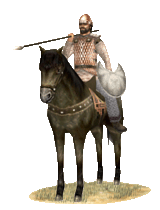 These medium cavalry represent a versatile task-force well able to perform a wide range of roles in battle. They are excellent screeners well-suited to guard the flanks of a battle-line, well able to cut lighty armed horsemen to ribbons, as well as their qualities in pursuit. Such qualities would make them a worthwhile addition to any commander. They are armed with a thrusting spear, which they bear in an overhanded manner, and a vicious axe with a back-spike allowing them several advantages in melee. As such they are also suited for flanking and supportive roles. Still however, they are not well-suited to take on heavier cavalry or elite infantry formations, and their loyalty is only markedrsemen were prevalent around Asia Minor, the Near East, and further eastwards, marking them as an ethnically diverse contingent consisting of "Eastern" peoples, including Medeans, Persians, Albanians, Iberians, Armenians, Cappadocians and Syrians willing to fight for any wealthy master in exchange for whatever that may feed their horses and themselves for a longer term. As such, their equipment and clothing would also have differed, though not always were such horsemen drastically diverse in ethnical disposition. Comparatively they may be seen as a heavier variation of Pantodapoi horsemen. These medium cavalry represent a versatile task-force well able to perform a wide range of roles in battle. They are excellent screeners well-suited to guard the flanks of a battle-line, well able to cut lighty armed horsemen to ribbons, as well as their qualities in pursuit. Such qualities would make them a worthwhile addition to any commander. They are armed with a thrusting spear, which they bear in an overhanded manner, and a vicious axe with a back-spike allowing them several advantages in melee. As such they are also suited for flanking and supportive roles. Still however, they are not well-suited to take on heavier cavalry or elite infantry formations, and their loyalty is only markedrsemen were prevalent around Asia Minor, the Near East, and further eastwards, marking them as an ethnically diverse contingent consisting of "Eastern" peoples, including Medeans, Persians, Albanians, Iberians, Armenians, Cappadocians and Syrians willing to fight for any wealthy master in exchange for whatever that may feed their horses and themselves for a longer term. As such, their equipment and clothing would also have differed, though not always were such horsemen drastically diverse in ethnical disposition. Comparatively they may be seen as a heavier variation of Pantodapoi horsemen.
Galatikoi Lavotuxri (Galatian Heavy Cavalry)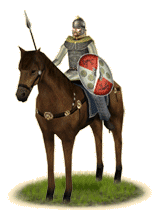 The Lavotuxri are cavalrymen, made up of young Galatian nobles and aristocrats of military age. They fight in the same manner as Gallic cavalry in Western Europe, although they wear tunics of brighter colors to better stand the Anatolian heat. They are equipped with Gallic-style chain mail, Gallic helmets and large round shields. They also carry Celtic longswords and spears. Their horses, if not stolen are imported from the steppes north the Pontos Euxine, Armenia or even Media. The Lavotuxri are good medium cavalry, well able to do their part on the battlefield as long as they are used in that role. The Lavotuxri are cavalrymen, made up of young Galatian nobles and aristocrats of military age. They fight in the same manner as Gallic cavalry in Western Europe, although they wear tunics of brighter colors to better stand the Anatolian heat. They are equipped with Gallic-style chain mail, Gallic helmets and large round shields. They also carry Celtic longswords and spears. Their horses, if not stolen are imported from the steppes north the Pontos Euxine, Armenia or even Media. The Lavotuxri are good medium cavalry, well able to do their part on the battlefield as long as they are used in that role.
Historically, the Lavotuxri were skilled cavalrymen and could often be found in service to the Successor states, but were most prominent in the armies of Pergamon and Pontos. The wars of the Hellenistic monarchies provided ample opportunity for the Galatians to seek their fortunes as mercenaries, and they were highly sought after. From the time they crossed into Anatolia until the battle of Actium, Galatians were involved in almost every major battle and war in the eastern Mediterranean.
Prodromoi (Successor Medium Cavalry)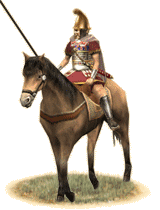 Prodromoi are the lightest of the Diadochoi melee cavalry and can be counted upon as superb flanking, raiding, and screening cavalry. They are well trained for light cavalry, but are still lightly armed and armored. They are not meant to be used as shock cavalry and will not roll up an enemy battle line in a thunderous charge, but instead make viable flanking cavalry which can quickly provide support where it is needed and be used to counter light missile troops of both the foot and mounted varieties. Their spears, shields, and linen armor give them some staying power, but they should not be used to in protracted melee for any great amount of time. Prodromoi are the lightest of the Diadochoi melee cavalry and can be counted upon as superb flanking, raiding, and screening cavalry. They are well trained for light cavalry, but are still lightly armed and armored. They are not meant to be used as shock cavalry and will not roll up an enemy battle line in a thunderous charge, but instead make viable flanking cavalry which can quickly provide support where it is needed and be used to counter light missile troops of both the foot and mounted varieties. Their spears, shields, and linen armor give them some staying power, but they should not be used to in protracted melee for any great amount of time.
Historically, the Seleukidai and Makedones used the smaller and weaker members of the nobility to form a quick and powerful light cavalry force that could decide an engagement on its own. Since these men are nobles, they have good staying power, as was evidenced by their widespread use in many battles. They are quick, and can be used to chase down missile cavalry when there is a need, due to the fact that they ride fast Thessalian horses and are relatively slight statured men. The Seleukidai use them as an effective counter to the Parthoi horse archers, much like the Hungarians of a later era did against the Turks.
Lonchophoroi Hippeis (Hellenic Medium Cavalry)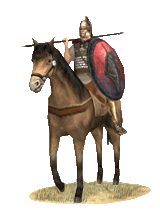 Hail Stratege! Fine noblemen forming a sturdy body of cavalry whose purpose is to crash into your foe and have the staying power to breach his line are here, arrayed before you. Armed with stout single handed lances and the mighty aspis of our ancestors, they can unleash a terrible charge. Once they have inflicted gruesome casualties on our enemies, they will switch to their melee weapon and begin a close-in slaughter. While men from Epeiros or Makedonia proper would have the sturdy Kopis, men further east may prefer the stout bladed war axe like that used by Alexander at the Granicus. They are armored with scale reinforced linen, greaves, and masked Phrygrian helmets that betray naught but the angry face of Zeus Pater or wrathful Poseidon. They are best used as a general purpose heavy cavalry. However, if facing the sturdier men from the east, or, Gods forbid, the elite Hetairoi or massive Kataphraktoi of the Seleukides and Baktrioi, they may not have the staying power that they would against other heavy cavalry. Use them well, and they will give your enemies naught but the death they so richly deserve! Hail Stratege! Fine noblemen forming a sturdy body of cavalry whose purpose is to crash into your foe and have the staying power to breach his line are here, arrayed before you. Armed with stout single handed lances and the mighty aspis of our ancestors, they can unleash a terrible charge. Once they have inflicted gruesome casualties on our enemies, they will switch to their melee weapon and begin a close-in slaughter. While men from Epeiros or Makedonia proper would have the sturdy Kopis, men further east may prefer the stout bladed war axe like that used by Alexander at the Granicus. They are armored with scale reinforced linen, greaves, and masked Phrygrian helmets that betray naught but the angry face of Zeus Pater or wrathful Poseidon. They are best used as a general purpose heavy cavalry. However, if facing the sturdier men from the east, or, Gods forbid, the elite Hetairoi or massive Kataphraktoi of the Seleukides and Baktrioi, they may not have the staying power that they would against other heavy cavalry. Use them well, and they will give your enemies naught but the death they so richly deserve!
Historically, the lancers of later Hellenistic armies were divided into several types. Some cavalry performed shock roles as a secondary function, with the charge itself being their goal, and thus it became necessary to develop a specific force of cavalry who could charge in suppport but lend staying power to their comrades. This sort of cavalry was used to great effect by the forces of Syrakousai and Taras in the west, Epeiros, Pergamon and Makedonia in the heartland of the Greek and Makedonian peoples, and the even the great Hellenistic kingdoms of Aigyptos, Syria, and Baktria. They appear on both sides at the battle of Magnesia, where they and the Pergamene Hetairoi checked the advance of more heavily armored Seleukid cavalry, allowing the Romans to roll up the line of Seleukid infantry. Still, they have some weaknesses, and should not be expected to defeat elite troops in prolonged battle.
Hellenikoi Kataphraktoi (Hellenic Cataphracts)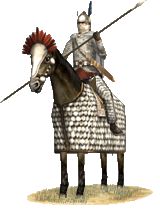 After suffering heavy losses to the Parthai and Armenioi Kataphraktoi, the Seleukidos and Baktrian empires produced their own versions of these heavy horsemen, both adapting the tactics and style of warfare to Hellenic technology and using superior metalwork to make them even more heavily armored. They are armored in an expensive combination of lamellar armor and chain, with heavy felt sandwiched in the middle. The resulting armor is tough and flexible, but offers outstanding protection. They are to be used as heavy shock cavalry, and have staying power in melee because of the sheer weight of their armor. They are slightly heavier than their Parthai counterparts, but lack the deadly maces that the Parthai carry and also the élan of their elite Parthai counterparts. Their horses are more heavily armored than those of the Hetairoi, but they lack the characteristic fierceness and discipline of the elite Diadochoi cavalry. After suffering heavy losses to the Parthai and Armenioi Kataphraktoi, the Seleukidos and Baktrian empires produced their own versions of these heavy horsemen, both adapting the tactics and style of warfare to Hellenic technology and using superior metalwork to make them even more heavily armored. They are armored in an expensive combination of lamellar armor and chain, with heavy felt sandwiched in the middle. The resulting armor is tough and flexible, but offers outstanding protection. They are to be used as heavy shock cavalry, and have staying power in melee because of the sheer weight of their armor. They are slightly heavier than their Parthai counterparts, but lack the deadly maces that the Parthai carry and also the élan of their elite Parthai counterparts. Their horses are more heavily armored than those of the Hetairoi, but they lack the characteristic fierceness and discipline of the elite Diadochoi cavalry.
Historically, Hellenistic Kataphraktoi were at least as good as their Parthai enemy, but most Seleukidoi commanders did not quite understand how to use this cavalry. They won great victories over the Parthai when supporting the tougher and more elite Hetairoi, compelling the Parthai to settle for a peace treaty and suzerainty over some of the Seleukidoi eastern possessions. They passed into history when most of the unit was bribed by Pompey during his conquest of the east. They formed the basis for the Romaioi kataphraktoi of later ages.
Argyraspides (Hellenic Elite Phalanx)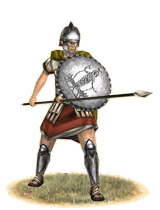 The veteran Pezhetairoi are often called Argyraspidai ("Silver Shields") in Makedonia, while in Arche Seleukeia they are drawn from the sons of mainly Makedonian military-settlers, primarily from the katoikiai, or military settlements, of Syria. These are tough men often better armed than their fellow phalanx soldiers, who usually are used to hold the center of a Makedonian or Seleukid battle line. They are older and more disciplined than other phalangitai and are thus able to hold their own against good odds. They are armed and armored much the same as regular Pezhetairoi, but with slightly better equipment and weapons, including scale reinforcement on their Linothorax. As with most elite units, they are best utilized as troops that take the brunt of an assault and can be counted upon to hold their ground. The veteran Pezhetairoi are often called Argyraspidai ("Silver Shields") in Makedonia, while in Arche Seleukeia they are drawn from the sons of mainly Makedonian military-settlers, primarily from the katoikiai, or military settlements, of Syria. These are tough men often better armed than their fellow phalanx soldiers, who usually are used to hold the center of a Makedonian or Seleukid battle line. They are older and more disciplined than other phalangitai and are thus able to hold their own against good odds. They are armed and armored much the same as regular Pezhetairoi, but with slightly better equipment and weapons, including scale reinforcement on their Linothorax. As with most elite units, they are best utilized as troops that take the brunt of an assault and can be counted upon to hold their ground.
Historically, the Silver Shields were an elite force within the armies of Alexandros, made up of the veterans often in their mid-40s and upwards. After the death of Alexandros, the term "Argyraspidai" came to describe the veterans among the Pezhetairoi, the soldiers aged 45-60. How this happened is anyone's guess, but it is what came to pass. In Makedonia the term was used to describe the veteran pezhetairoi who more often than not weren't a distinct corps, while in Arche Seleukeia they became the royal Guard, and carrying a silver shield was a mark of the elite. The Seleukid Argyraspidai seems to have been kept at a constant strength of around 10.000 men. How they were recruited is disputed, but one theory says they were sons of military settlers, who served in the royal Guard while their fathers tilled their land allotments, which were hereditary. This also had the added bonus of making every Argyraspides know who the true king was and where his loyalties were to be. The Makedonian Argyraspidai eventually "died out" and was replaced by the reformed Pezhetairoi, while the Seleukid Argyraspidai evolved into an assault infantry corps, the Thorakitai Argyraspidai, although one source suggests that the 10.000 man Silver Shields corps was divided into two halves, where 5000 men continued to fight as phalangitai and the other 5000 were armed in the new "Thorakitai" style.
Hypaspistai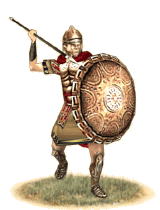 Hail, Basileu! Before you stand your Hypaspistai: the elite of the elite and your personal guard. They are armed and armored in the finest equipment of the traditional hoplite: aspis, greaves, cuirass, helmet, spear, and sword. They are the best and richest of your men; far too worthy to risk in unwise actions. And yet they are without a doubt capable of multiplying the power of your army. Forming the right wing of the battle line or leading the assault on fortifications their heavy armor and weapons allow them to stand against even the hardiest of opponents and triumph with ease. They should be deployed where the fighting will be at its absolute thickest or nearby to fight with and to protect you. Hail, Basileu! Before you stand your Hypaspistai: the elite of the elite and your personal guard. They are armed and armored in the finest equipment of the traditional hoplite: aspis, greaves, cuirass, helmet, spear, and sword. They are the best and richest of your men; far too worthy to risk in unwise actions. And yet they are without a doubt capable of multiplying the power of your army. Forming the right wing of the battle line or leading the assault on fortifications their heavy armor and weapons allow them to stand against even the hardiest of opponents and triumph with ease. They should be deployed where the fighting will be at its absolute thickest or nearby to fight with and to protect you.
Historically, the Hypaspistai (shield-bearers) first appear with Alexandros at the beginning of his reign as his elite troops and bodyguard. He used them extensively throughout his anabasis for special missions, assault of fortifications, and in support of light troops in rough terrain; however, details of the unit seem to disappear by the time Alexandros reaches India and remain as such until appearing in various sources for the three remaining Diadochoi kingdoms in different forms and perhaps briefly in Epeiros with Pyrrhos. Such examples of their deployment count them as possibly numbering a fifth of the 10,000 Arygraspides corps of the Seleukid kings or as the military police and closest guard of the Makedonian kings. Yet, despite their prowess, the Hypaspistai were either forced to evolve past the antiquated hoplite model as in the east or vanish with the fall of their kingdom as in the west.
Peltastai Makedonikoi (Hellenistic Elite Infantry)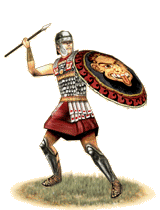 Hail, Basileu! These men are the Peltastai and among the elite of your army. Men in their prime and drawn from the upper echelons of society they have been fitted with fine armor, a sword, and javelins. They excel in assault where their javelins can scatter defenders from breaches in defenses made by your siege engines. In the open field, their equipment, lighter in comparison to the heavily armed Hypaspistai, makes them adept at flanking the enemy battle line or exploiting openings made by your other troops. Hail, Basileu! These men are the Peltastai and among the elite of your army. Men in their prime and drawn from the upper echelons of society they have been fitted with fine armor, a sword, and javelins. They excel in assault where their javelins can scatter defenders from breaches in defenses made by your siege engines. In the open field, their equipment, lighter in comparison to the heavily armed Hypaspistai, makes them adept at flanking the enemy battle line or exploiting openings made by your other troops.
Historically the elite Peltastai Makedonikoi appear at some point during the late 3rd century as the guard of the Antigonid kings and later with the other Diadochoi. The precise moment is not known due to scarcity of information concerning period between the Battle of Ipsos and start of second Punic War. It is from both Polybios and inscriptions found in Makedonia that we learn of them; that they were among the most fit Makedones available to the king; and likely the sons of noble families. They were younger than 35 and so at the peak physical strength for the average man. Their role in war was similar to that of Hypaspistai in the army of Alexander the Great: assault of fortifications, supporting light troops in broken terrain, and performing special missions that required both skill and strength. In set battles they could be equipped with sarissai and fight with the phalanx positioned in the place of honor at the right wing close to the king. Commanders of the Peltastai were among the most important persons in kingdom, as evidenced by Antigonos Doson's naming the contemporary commander of the unit, along with four others, as protector of a young Phillipos V.
Thorakitai Agematos Basilikou (Hellenic Elite Spearmen)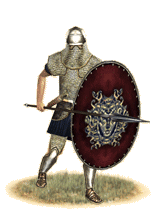 Arche, King of all Asia, I present your finest soldiers for review. Armed in the highest quality mail and bronze, these men are your heaviest assault infantry. Using tactics amalgamated from the finest soldiers of Alexander, mercenaries from far off lands, and the Galatians who form part of our invincible armies. They wield long spear, metal javelins, and swords in order to bore a hole through the enemy line, through which the rest of your mobile troops can pour like a flood through a dam rent asunder by a furious surge. Armored in the very best mail, made using Galatian techniques by Syrian armorers, fine greaves, a masked helmet, and many smaller accouterments, they are well able to stand up to any charge, though they can be overwhelmed by force of numbers. Arche, King of all Asia, I present your finest soldiers for review. Armed in the highest quality mail and bronze, these men are your heaviest assault infantry. Using tactics amalgamated from the finest soldiers of Alexander, mercenaries from far off lands, and the Galatians who form part of our invincible armies. They wield long spear, metal javelins, and swords in order to bore a hole through the enemy line, through which the rest of your mobile troops can pour like a flood through a dam rent asunder by a furious surge. Armored in the very best mail, made using Galatian techniques by Syrian armorers, fine greaves, a masked helmet, and many smaller accouterments, they are well able to stand up to any charge, though they can be overwhelmed by force of numbers.
Historically, the Seleukid Hypaspistai went through a myriad of changes, trying to keep up with the ever shifting dynamic of warfare. One innovation was the creation of heavy units, at first using a mix of Greek and Gallic organization, but later adopting structures similar to the Romans. The myth of the imitation legionary was born from this, though in reality the units still used Greek tactics and equipment that had been around for the better part of one hundred years before any Roman influence. These soldiers represent the heaviest units organized in this regard, and their esprit de corps is unmatched by any but the most elite soldiers in other factions. Use them well, for they are the fist of any infantry assault.
Hetairoi (Companion Cavalry)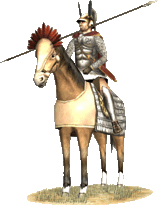 The Hetairoi, or Companions, were the elite noble heavy cavalry of Makedon and the Diadochoi. They are an elite heavy cavalry that is second to none and arguably the best cavalry of the period. They fight with a degree of élan, discipline, and simple ferociousness that is matched only by the horsemen of Iberia, Karchedon, and the best heavy cavalry of the eastern nomadic peoples. They are armored from head to toe in iron plate (some still had bronze, but this was falling out of favor rapidly by 250 BC), reinforced with mail at key points. Their horses are barded with felt barding and often have bronze plates to protect their heads. Their helmets, with the two plumes, mark them on a battlefield. They are best used as heavy shock cavalry, able to decide many battles with a single charge. They are the second part of the hammer and anvil of Alexandrian battle tactics. They are armed with a xyston and a kopis, and are true masters of both weapons. If these men have any weakness, it is the front of a line of spearmen. Horses, not matter how well trained, simply do not want to charge into certain death. Nevertheless, these superb cavalry men are easily able to devastate even the toughest of foes with a well timed charge into their flanks or rear. The Hetairoi, or Companions, were the elite noble heavy cavalry of Makedon and the Diadochoi. They are an elite heavy cavalry that is second to none and arguably the best cavalry of the period. They fight with a degree of élan, discipline, and simple ferociousness that is matched only by the horsemen of Iberia, Karchedon, and the best heavy cavalry of the eastern nomadic peoples. They are armored from head to toe in iron plate (some still had bronze, but this was falling out of favor rapidly by 250 BC), reinforced with mail at key points. Their horses are barded with felt barding and often have bronze plates to protect their heads. Their helmets, with the two plumes, mark them on a battlefield. They are best used as heavy shock cavalry, able to decide many battles with a single charge. They are the second part of the hammer and anvil of Alexandrian battle tactics. They are armed with a xyston and a kopis, and are true masters of both weapons. If these men have any weakness, it is the front of a line of spearmen. Horses, not matter how well trained, simply do not want to charge into certain death. Nevertheless, these superb cavalry men are easily able to devastate even the toughest of foes with a well timed charge into their flanks or rear.
Historically, the Hetairoi were first created by Philippos, following the lead of the cavalrymen of Thessalia, to the south. Philippos went one better, armoring them to the teeth and giving them the xyston, a twelve foot long lance tipped with a large steel head. They were armored head to toe in bronze plate, with helms, cuirass, bracers and greaves. Alexandros often replaced this armor with lighter linen when they were traveling, but was quick to replace the bronze in any hard fought engagement. Alexandros added little to their equipment but trained them to ride their horses in such a way that each man was an expert horsemen as well as a shock cavalryman. The Diadochoi kept this mold, but added mail reinforcement to the bronze armor at the joints before replacing it with iron and added felt and lamellar barding to the horses after encountering enemy cavalry that used such equipment with a high degree of success. During the third century their usage declined with the Diadochoi's ability to pay for such heavily armored men. They degenerated to such a point where only a handful were present at major battles, and were far from the war winning force that they had been earlier. Perhaps with a bit of luck and more funding, a commander could use them in their true glory once more…
Elephantes Indikoi (Indian Elephants)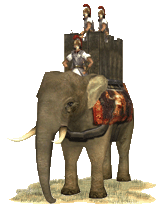 Imported from the regions around the old Eastern Persian provinces, Elephantes Indikoi are an exceptionally valuable resource in combat, very popular among Alexandros' Diadochoi. Towering over most other creatures, they can easily scare men and horses alike, with both their size and smell, though elaborate bells and trappings often add to their intimidation. Such corps are directed by their own mahouts riding behind their heads, often a native of their own country who has spent at least two years training his beast from capture. The mahout is armored to better protect against the obvious assault that generally comes against him, launched to bypass the thick natural armor of his mount. Imported from the regions around the old Eastern Persian provinces, Elephantes Indikoi are an exceptionally valuable resource in combat, very popular among Alexandros' Diadochoi. Towering over most other creatures, they can easily scare men and horses alike, with both their size and smell, though elaborate bells and trappings often add to their intimidation. Such corps are directed by their own mahouts riding behind their heads, often a native of their own country who has spent at least two years training his beast from capture. The mahout is armored to better protect against the obvious assault that generally comes against him, launched to bypass the thick natural armor of his mount.
Elephants are best used as cavalry screens for your army, where their presence can scare away enemy cavalry. They can also be used to ram through an enemy battle line, though they are less useful when faced with loose order or phalanx infantry. Pyrrhos of Epeiros even innovated a tactic of flank screens when he fought the Romans at Heraklea. Beyond their obvious use against enemy infantry or cavalry, they can also be used in siege combat; battering down gates, though they're highly vulnerable to better prepared installations. Their greatest vulnerability is against skirmishers, slingers and archers, who can pepper them with missiles - eventually toppling them by virtue of their cumulative impact. To counter the effect of enemy skirmishers, it is often wise to array your own in opposition, or to maintain constant attacks upon each individual group.
Historically, the use of elephants in war was largely contained to India, but after the battle of Hydaspes that changed. Though Alexandros never cared over much for the animals, his successors were very much in favor of their use, organizing their own elephants into a distinct corps under their own "elephantarchos". These "Elephantes Indikoi" (Indian Elephants) were imported for war in the West from the old Eastern Persian provinces around Baktria, Gandhara, Sattagydia, and Sind - though most originally hailed from the regions directly around the river the natives call the Sindhu. In the first wars of succession, each Diadochoi had a contingent of Indian elephants and Indian mahouts, who stayed on where they taught the Hellenes how to capture and train elephants for war. Such forces had been wreaking havoc on battle lines for centuries within the armies of Indian Rajas, and the Diadochoi used them on an equal scale (the first substantial group supposedly numbered 500 elephants total, granted to Seleukos I Nikator by his new ally Chandragupta Maurya, called "Sandrokottos" in Greek), attaching substantial political power to their possession - some officers gained temporary power and success simply by this virtue (most notably, the Eastern Satrap Eumenes).
Despite their great usefulness when properly employed, it was not unusual for elephants to cause defeat for those who employed them. If an enemy was clever enough to devise their own means to combat elephants, as was the case at the battle of Gaza when Ptolemaios planted an ‘iron spiked minefield’ to ward off elephants, or when Caesar properly utilized slingers and Scipio gaps between his infantry cohorts to channel the elephants, they could be defeated and even turned against their masters. Even pigs were used on occasion, released among elephants who were often scared of their comparatively small, darting forms. However, despite the many different weapons and stratagems being devised to fight them and the huge expenses required to maintain them, the elephant was still considered a valuable asset, maintained widely. The Arche Seleukeia even developed a corps of ‘elephant guards,' whose task was simply to defend the beasts in combat.
Other non-Hellenic powers also used Indian elephants in war, but it seems not to the same great extent. These powers started using elephants when they gained control of Indian provinces, such as the Pahlava, Kushan Empire and the Indo-Saka kingdoms.
Elephantes Kataphraktoi Indikoi (Armoured Indian Elephants)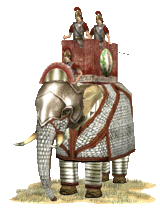 Imported from the regions around the old Eastern Persian provinces, Elephantes Kataphraktoi Indikoi are an exceptionally valuable resource in combat, very popular among Alexandros' Diadochoi. Towering over most other creatures, they can easily scare men and horses alike, with both their size and smell, though elaborate bells and trappings often add to their intimidation. Such corps are directed by their own mahouts riding behind their heads, often a native of their own country who has spent at least two years training his beast from capture. The mahout is armored to better protect against the obvious assault that generally comes against him, launched to bypass the thick natural armor of his mount. A thorakion (tower) or howdah is also attached to the elephant's back, which serves as a missile platform for a few archers. The elephant itself is also armored, protecting its head and sides and thus giving the elephants a much better chance at resisting enemy missile fire. Imported from the regions around the old Eastern Persian provinces, Elephantes Kataphraktoi Indikoi are an exceptionally valuable resource in combat, very popular among Alexandros' Diadochoi. Towering over most other creatures, they can easily scare men and horses alike, with both their size and smell, though elaborate bells and trappings often add to their intimidation. Such corps are directed by their own mahouts riding behind their heads, often a native of their own country who has spent at least two years training his beast from capture. The mahout is armored to better protect against the obvious assault that generally comes against him, launched to bypass the thick natural armor of his mount. A thorakion (tower) or howdah is also attached to the elephant's back, which serves as a missile platform for a few archers. The elephant itself is also armored, protecting its head and sides and thus giving the elephants a much better chance at resisting enemy missile fire.
Elephants are best used as cavalry screens for your army, where their presence can scare away enemy cavalry. They can also be used to ram through an enemy battle line, though they are less useful when faced with loose order or phalanx infantry. Pyrrhos of Epeiros even innovated a tactic of flank screens when he fought the Romans at Herakleia. Beyond their obvious use against enemy infantry or cavalry, they can also be used in siege combat; battering down gates, though they're highly vulnerable to better prepared installations. Their greatest vulnerability is against skirmishers, slingers and archers, who can pepper them with missiles - eventually toppling them by virtue of their cumulative impact. To counter the effect of enemy skirmishers, it is often wise to array your own in opposition, or to maintain constant attacks upon each individual group. These "towered" elephants though are much less vulnerable then their unarmored corps, well protected as they are by their own armor and skirmisher mounts of their own.
Historically, the use of elephants in war was largely contained to India, but after the battle of Hydaspes that changed. Though Alexandros never cared over much for the animals, his successors were very much in favor of their use, organizing their own elephants into a distinct corps under their own "elephantarchos". These "Elephantes Kataphraktoi Indikoi" (Armoured Indian Elephants) were imported for war in the West from the old Eastern Persian provinces around Baktria, Gandhara, Sattagydia, and Sind - though most originally hailed from the regions directly around the river the natives call the Sindhu. In the first wars of succession, each Diadochoi had a contingent of Indian elephants and Indian mahouts, who stayed on where they taught the Hellenes how to capture and train elephants for war. Such forces had been wreaking havoc on battle lines for centuries within the armies of Indian Rajas, and the Diadochoi used them on an equal scale (the first substantial group supposedly numbered 500 elephants total, granted to Seleukos I Nikator by his new ally Chandragupta Maurya, called "Sandrokottos" in Greek), attaching substantial political power to their possession - some officers gained temporary power and success simply by this virtue (most notably, the Eastern Satrap Eumenes).
However, even with many different anti-elephant weapons being used and with the huge expenses, time and effort that had to be put into maintaining an elephant herd, the elephant was still employed so it shows that it was still valued and served its purpose. The Seleukides even developed specific ‘elephant guards’ units, whose task was to solely defend these beasts. The elephant riders or the mahouts, were often called Indoi, as in the beginning they were all Indians and the majority of mahouts continued to be Indians, yet they did teach their skills to ‘westerners’ as well, as the Ptolemaioi did not have access to India yet they kept a sizeable elephant corps. The mahouts often wore protective armor as they were an obvious target for enemy missiles, even though ancient artists often portray them unarmored, which is highly likely to have been how they dressed for parades.
Other non-Hellenic powers also used Indian elephants in war, but it seems not to the same great extent. These powers started using elephants when they gained control of Indian provinces, such as the Pahlava, Kushan Empire and the Indo-Saka kingdoms.
|
 |
|
 |






















|